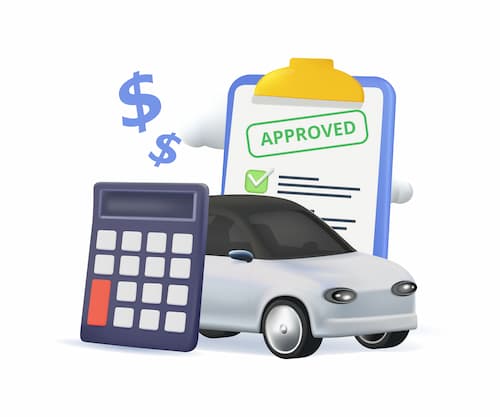- The main factors that affect car insurance rates: Demographics, vehicle, policy and insurance history
- How car insurance companies weigh factors differently and why it means you should shop around
- Which factors are causing car insurance rates to rise?
- How understanding car insurance rating factors can help you save money
- How do insurance companies use the various factors to determine rates?
- FAQ: Factors that affect car insurance rates
The main factors that affect car insurance rates: Demographics, vehicle, policy and insurance history
The factors that affect the cost of car insurance fall into four main categories: factors about the driver and where they live (demographics), factors about the vehicle and how it's used, factors about the policy and your insurance history.
| Demographics | Vehicle/vehicle use | Policy | Insurance history |
|---|---|---|---|
| Age/years licensed | Year, make and model | Coverage types and limits | Previous insurance |
| Gender* | Safety features | Deductibles | Claims history |
| Driving record | Anti-theft features | State-mandated coverage | Coverage lapses |
| Location | Annual mileage | Past cancellations | |
| Marital status | How the vehicle is used | ||
| Credit history* |
* Not permitted in some states
“Auto insurers typically use more than a dozen rating factors to determine the cost of your insurance policy. Some common factors are prohibited in certain states, such as credit history, gender and ZIP code,” said Mark Friedlander with the Insurance Information Institute. “Factors that are allowed in all states include your motor vehicle record, claimAn insurance claim is a request you make to your insurance company for coverage after your car is damaged or you have an accident. You can file a claim online, by phone, or in writing. history, location (city/state) and the type of vehicle you drive, as well as the coverage levels and deductibles you choose.”
Let’s dive into specific factors that impact car insurance rates.
Age
Teens and young drivers pay much higher car insurance rates since they lack experience behind the wheel. As you get older, rates lower significantly. However, once drivers reach their senior years, usually over 65, rates increase again due to more health problems and slower reaction times. Hawaii and Massachusetts have banned the use of age as a car insurance rating factor, but years of driving experience can still be considered.
Years of driving experience
How much time you’ve spent behind the wheel is significant. Drivers with more experience are more adept at avoiding accidents and being defensive drivers. You will see higher car insurance rates if you’re an older driver who just received your license. Even in states where age is banned as a factor, years of driving experience can still be used.
Gender
Both age and gender affect car insurance rates. Male drivers tend to take more risks, such as speeding, than female drivers. Car insurance companies usually charge males higher rates until they are older. However, some states, such as California, Florida, Hawaii, Massachusetts, Michigan, North Carolina and Pennsylvania, don’t allow insurers to consider or limit the use of gender when calculating rates.
Driving record: Tickets and accidents
Your driving record is one of the best indicators of risk. Drivers with tickets, accidents and DUIs on their records are more likely to cause accidents and file claims. Multiple infractions on your driving record can cause rates to skyrocket.
Marital status
Married drivers are perceived to be more stable and less likely to take risks. Insurers often offer discounts to less risky drivers, which lower rates significantly.
Where you live: State and ZIP code
Some areas of the country are more likely to be hit with natural disasters or have high vehicle theft rates, while others have higher accident rates. Drivers in these areas pay more for insurance since their vehicles are more likely to be damaged.
Credit history
Statistically, drivers with a lower credit score are more likely to file a claim. It should be noted that California, Hawaii, Massachusetts and Michigan don’t allow insurers to use credit scores to calculate rates.
Annual mileage
Drivers who spend a lot of time on the road have a greater chance of being in an accident. Where you drive can also impact your rates since driving in an area with a lot of traffic or animal encounters can lead to more accidents.
Vehicle type: Year, make and model
Your vehicle’s make and model affect its insurance rate. Cars with good safety ratings see lower rates. Expensive luxury and exotic cars typically have enhanced technology and harder-to-obtain parts. These vehicle parts and systems are more costly to repair or replace, and labor costs are also increased, resulting in higher insurance rates.
Vehicle use: Pleasure, commute, business
Insurers charge more for coverage if you use your vehicle to drive to work every day rather than leaving it parked in your driveway most of the time, whether that’s because you work from home or you use public transportation to commute.
Coverage types, limits and deductibles
Higher coverage levels and lower deductibles mean more costs for the insurance company but lower out-of-pocket costs if your vehicle is damaged. Rates are higher based on the amount an insurer might have to pay if you file a claim.
Previous claims
Drivers who’ve filed numerous claims in the past are more likely to continue to cost insurers money, so car insurance rates increase dramatically with each claim. Insurance rates may increase after a claim even if you didn’t cause the accident.
Previous insurance and coverage lapses
Driving without car insurance is illegal in most states. Insurers want to know that you’ve had continuous coverage, and a lapse in coverage indicates you may be a risky driver.
How car insurance companies weigh factors differently and why it means you should shop around
All insurers use the same list of factors to determine coverage rates, but not all insurers weigh these factors equally.
That means that:
- One company might charge a lot more than another for a speeding ticket or an accident
- Some companies have much lower rates for teen drivers, while others cater to seniors
- Not all companies increase rates for poor credit, and a few don't consider it at all
The best way to find affordable car insurance rates is to compare quotes from numerous insurers, as each insurer weighs the factors involved differently. It can make a difference of hundreds of dollars, if not thousands.
Which factors are causing car insurance rates to rise?
Like other sectors of the economy, car insurance costs are rising. These are among the factors to blame:
- Increasing labor and parts costs
- More technology in new cars makes repairing them more costly
- Increased severe weather events, such as floods and hurricanes
- Tariffs on parts and materials used to repair cars
Most of the factors that are causing insurance rates to rise are not related to the individual factors that affect your rates. That means those factors are impacting drivers across the board; however, your rates are still impacted by all of your personal factors as well.
How understanding car insurance rating factors can help you save money
Although you can’t change your age or gender, there are changes you can make that lower your car insurance rates.
Consider making changes such as:
- Improve your driving record. Traffic violations stop impacting car insurance rates after a few years. Avoid adding tickets, accidents and DUIs to clear your driving record and get better rates.
- Consider a less expensive vehicle. To get lower rates, consider a cheaper car that is less expensive to repair or replace.
- Lower coverage and raise deductibles. Only carry the necessary coverage and prepare to pay more out of pocket if you file a claim.
- Reconsider filing a claim. If you can pay for repairs, consider skipping the insurance company to keep rates low.
- Raise your credit score. Make on-time payments and carefully consider how you use credit to lower car insurance rates.
How do insurance companies use the various factors to determine rates?
Car insurance companies follow a few steps to determine how much to charge each driver:
- Each driver is sorted into a base category determined by their age, gender and ZIP code
- The year, make and model of your vehicle is factored into the based rate
- Driving history is reviewed and surcharges are added for any tickets or accidents
- Other driver factors like credit history and insurance lapses are factored in and rates adjusted
- Discounts for which you qualify are applied
Complicated systems do these calculations quickly, allowing you to get a quote fast. However, any misinformation on your quote request could mean higher rates when the policy is issued.
FAQ: Factors that affect car insurance rates
Why is car insurance expensive in some states?
Car insurance rates are higher in states with a high number of thefts, a large volume of traffic or natural disasters. Insurers charge higher rates because they are more likely to pay repair or replacement claims. State laws for minimum car insurance requirements also play a role in costs; no-fault states generally have higher car insurance costs.
Why does having a higher deductible lower your insurance premiums?
Your deductibleThe deductible is the amount you pay out of pocket for a covered loss when you file a claim. is the amount you pay out of pocket before your insurance kicks in when you file a claim. The more you pay yourself, the less the insurance company pays, which leads to lower rates.
What types of drivers generally pay more?
Young, inexperienced drivers and drivers with a bad driving record typically pay higher car insurance rates. Additionally, male drivers and people with poor credit ratings pay increased rates.



